1998 PONTIAC GRAND PRIX Engine
[x] Cancel search: EnginePage 359 of 402
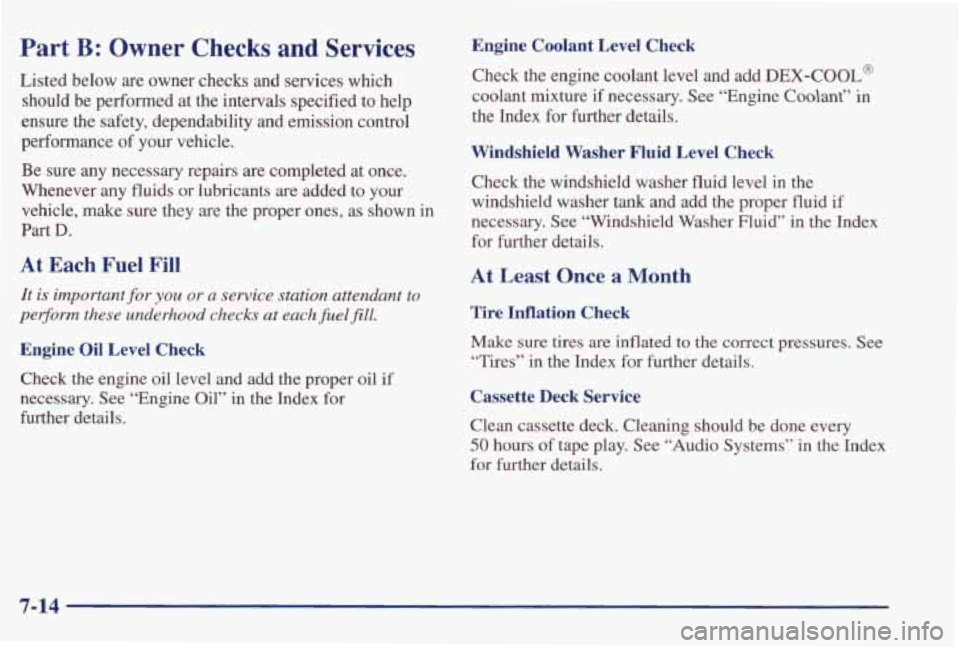
Part B: Owner Checks and Services
Listed below are owner checks and services which should be performed at the intervals specified
to help
ensure the safety, dependability and emission control
performance of your vehicle.
Be sure any necessary repairs are completed at once.
Whenever any fluids or lubricants
are added to your
vehicle, make sure they are the proper ones, as shown in
Part D.
At Each Fuel Fill
It is important for you or a service station attendant to
perjiorm these underhood checks at each fuel fill.
Engine Oil Level Check
Check the engine oil level and add the proper oil if
necessary. See “Engine Oil” in the Index for
further details.
Engine Coolant Level Check
Check the engine coolant level and add DEX-COOL@
coolant mixture if necessary. See “Engine
Coohnt” in
the Index for further details.
Windshield Washer Fluid Level Check
Check the windshield washer fluid level in the
windshield washer tank and add the proper fluid
if
necessary. See “Windshield Washer Fluid” in the Index
for further details.
At Least Once a Month
Tire Inflation Check
Make sure tires are inflated to the correct pressures. See
“Tires” in the Index for further details.
Cassette Deck Service
Clean cassette deck. Cleaning should be done every
50 hours of tape play. See “Audio Systems’’ in the Index
for further details.
7-14
Page 361 of 402

Starter Switch Check
1-
Brake-Transaxle Shift Interlock (BTSI) Check
r-
When you are doing this check, the vehicle could move suddenly.
If it does, you or others could be
injured. Follow the steps below.
A CAUTION:
When you are doing this check, the vehicle could
move suddenly.
If it does, you or others could be
injured. Follow the steps below.
1.
2.
3.
Before you start, be sure you have enough room
around the vehicle.
Firmly apply both the parking brake (see “Parking
Brake” in the Index if necessary) and the
regular brake.
NOTE: Do not use the accelerator pedal, and be
ready to
turn off the engine immediately if it starts.
Try to start the engine in each gear. The starter
should work only
in PARK (P) or NEUTRAL (N). If
the starter works in any other position, your vehicle
needs service.
1. Before you start, be sure you have enough room
around the vehicle. It should be parked on a
level surface.
2. Firmly apply the parking brake (see “Parking Brake”
in the Index if necessary).
NOTE: Be ready to apply the regular brake
immediately if the vehicle begins to move.
3. With the engine off, turn the key to the RUN
position, but don’t start the engine. Without applying
the regular brake,
try to move the shift lever out of
PARK
(P) with normal effort. If the shift lever
moves out
of PARK (P), your vehicle’s BTSI
needs service.
7-16
Page 362 of 402
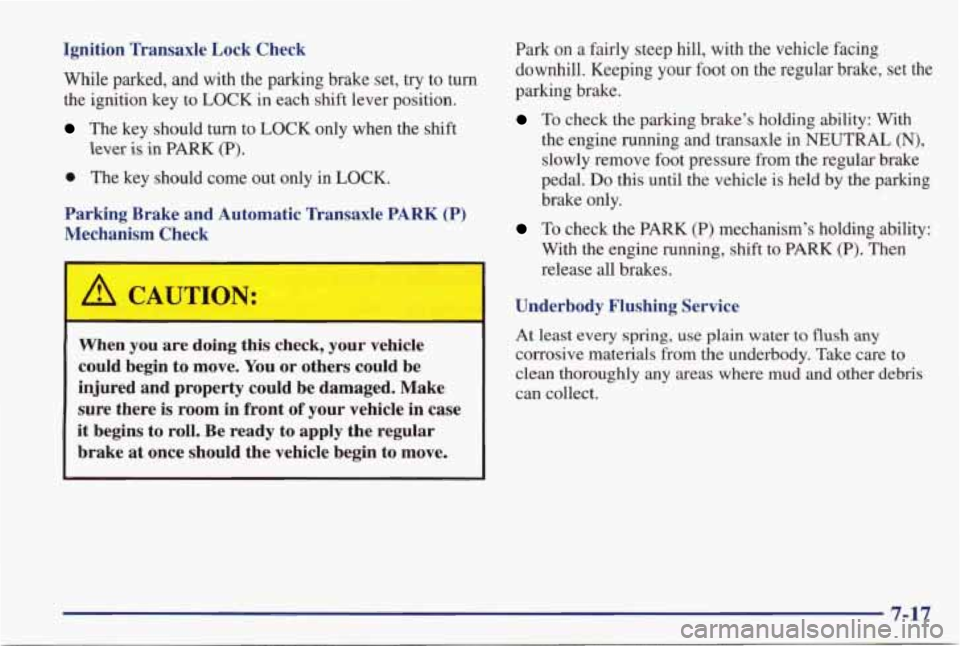
Ignition Transaxle Lock Check
While parked, and with the parking brake set,
try to turn
the ignition key to LOCK in each shift lever position.
The key should turn to LOCK only when the shift
lever is in PARK (P).
0 The key should come out only in LOCK.
Parking Brake and Automatic Transaxle PARK
(P)
Mechanism Check
1
Park on a fairly steep hill, with the vehicle facing
downhill. Keeping your foot on the regular brake, set the
parking brake.
To check the parking brake’s holding ability: With
the engine running and transaxle in
NEUTRAL (N),
slowly remove foot pressure from the regular brake
pedal. Do this until the vehicle is held by the parking
brake only.
To check the PARK (P) mechanism’s holding ability:
With the engine running, shift to
PARK (P). Then
release
all brakes.
Underbody Flushing Service
At
least every spring, use plain water to flush any
corrosive materials from the underbody. Take care to
clean thoroughly any areas where mud and other debris
When you are doing this check, your vehicle
could begin
to move. You or others could be
injured and property could be damaged. Make
it begins to roll. Be ready to apply the regular
sure there
is room in front of your
vehicle in case can collect.
brake
at once should the vehicle begin to move.
Page 363 of 402
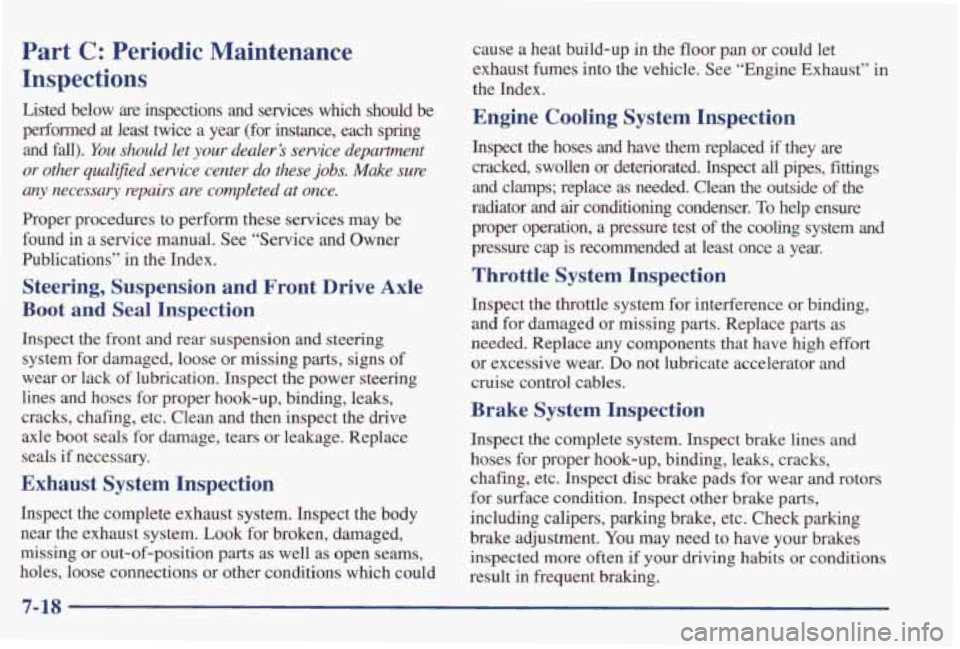
Part C: Periodic Maintenance
Inspections
Listed below are inspections and services which should be
perfunned at least twice a year (for instance, each spring
and
fall). You should let your dealer’s service department
or other qual$ed service center
do these jobs. Make sure
any necessary repairs are completed
at once.
Proper procedures to perform these services may be
found
in a service manual. See “Service and Owner
Publications” in the Index.
Steering, Suspension and Front Drive Axle
Boot
and Seal Inspection
Inspect the front and rear suspension and steering
system for damaged, loose or missing parts, signs of
wear or lack
of lubrication. Inspect the power steering
lines and hoses for proper hook-up, binding, leaks,
cracks, chafing, etc. Clean and then inspect the drive
axle boot seals for damage, tears or leakage. Replace
seals if necessary.
Exhaust System Inspection
Inspect the complete exhaust system. Inspect the body near the exhaust system. Look for broken, damaged,
missing or out-of-position parts
as well as open seams,
holes, loose connections or other conditions which could cause
a heat build-up in the floor pan or could let
exhaust fumes into the vehicle. See “Engine Exhaust’’ in
the Index.
Engine Cooling System Inspection
Inspect the hoses and have them replaced if they are
cracked, swollen or deteriorated. Inspect
all pipes, fittings
and clamps; replace
as needed. Clean the outside of the
radiator and
air conditioning condenser. To help ensure
proper
operation, a pressure test of the cooling system and
pressure cap is recommended at least once a year.
Throttle System Inspection
Inspect the throttle system for interference or binding,
and for damaged
or missing parts. Replace parts as
needed. Replace any components that have high
effort
or excessive wear. Do not lubricate accelerator and
cruise control cables.
Brake System Inspection
Inspect the complete system. Inspect brake lines and
hoses for proper hook-up, binding, leaks, cracks,
chafing, etc. Inspect disc brake pads for wear and rotors
for surface condition. Inspect other brake parts,
including calipers, parking brake, etc. Check parking
brake adjustment. You may need to have your brakes
inspected more often if your driving habits or conditions
result
in frequent braking.
7-18
Page 364 of 402
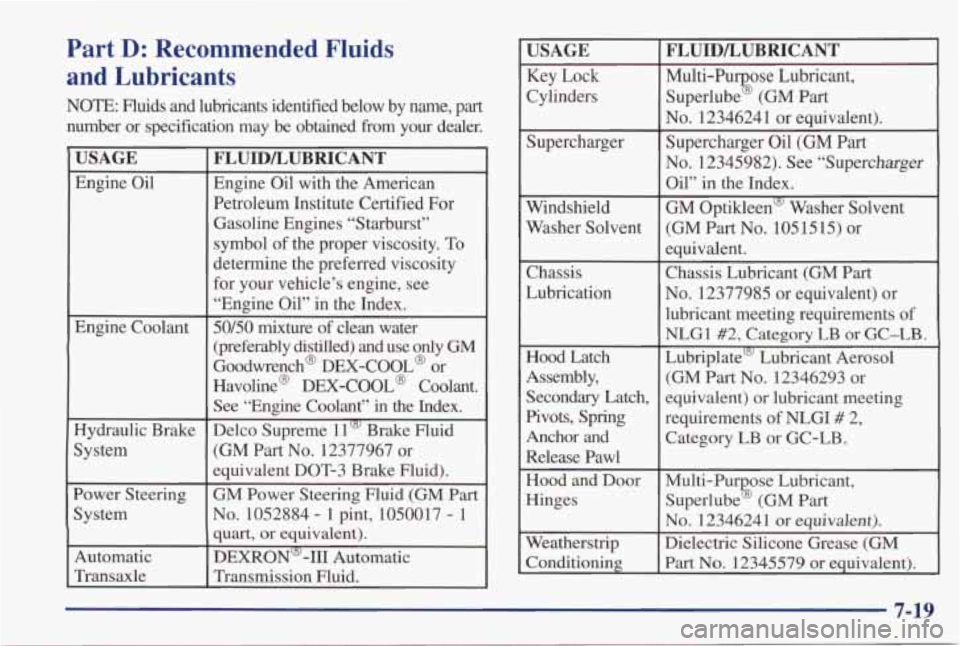
Part D: Recommended Fluids
and Lubricants
NOTE: Fluids and lubricants identified below by name, part number or specification may
be obtained from your dealer.
USAGE
Engine Oil
Engine Coolant
Hydraulic Brake
System
Power Steering
System
Automatic
Transaxle
FLUIDLUBRICANT
Engine Oil with the American
Petroleum Institute Certified For
Gasoline Engines “Starburst” symbol of the proper viscosity.
To
determine the preferred viscosity
for your vehicle’s engine, see
“Engine Oil” in the Index.
50/50 mixture of clean water
(preferably
distilled) and use only GM
Goodwrench@ DEX-COOL@ or
Havoline@ DEX-COOL@ Coolant.
See “Engine Coolant” in the Index.
Delco Supreme 11
vv Brake Fluid
(GM Part No. 12377967 or
equivalent DOT-3 Brake Fluid).
GM Power Steering Fluid (GM
Part
No. 1052884 - 1 pint, 1050017 - 1
quart, or equivalent).
DEXRONw-I11 Automatic
Transmission Fluid. -
USAGE
Key Lock
Cylinders
Supercharger
Windshield
Washer Solvent
Chassis
Lubrication
Hood Latch
Assembly, Secondary Latch,
Anchor and Pivots, spring
Release Pawl
Hood and Door Hinges
Weatherstrip
Conditioning
FLUIDLUBRICANT
Multi-Pu ose Lubricant,
Superlube
% (GM Part
No. 12346241 or equivalent).
Supercharger Oil (GM
Part
No. 12345982). See “Supercharger Oil” in the Index.
GM Optikleenw Washer Solvent
(GM
Part No. 1051515) or
equivalent.
Chassis Lubricant
(GM Part
No. 12377985 or equivalent) or
lubricant meeting requirements of
NLG1#2, Category LB
or GC-LB.
Lubriplate” Lubricant Aerosol (GM
Part No. 12346293 or
equivalent) or lubricant meeting
requirements of NLGI
# 2,
Category LB or GC-LB.
Multi-Pu ose Lubricant, Superlube
% (GM Part
No. 12346241 or equivalent).
Dielectric Silicone Grease (GM
Part No. 12345579 or equivalent).
7-19
Page 379 of 402

1998 PONTIAC SERVICE PUBLICATIONS ORDERING INFORMATION
The following publications covering the operation and servicing of your vehicle can be purchased by filling out
the Service Publication Order Form in this
book and mailing it in with your check, money order,
or credit card information to Helm, Incorporated (address below.)
CURRENT PUBLICATIONS FOR 1998 PONTIAC
SERVICE MANUALS
Service Manuals have the diagnosis and repair information
on engines, transmission, axle, suspension, brakes,
electrical, steering, body, etc.
RETAIL SELL PRICE: $90.00
TRANSMISSION, TRANSAXLE, TRANSFER CASE
UNIT REPAIR MANUAL
This manual provides information on unit repair service
procedures, adjustments and specifications for the
1998 GM transmissions, transaxles and transfer cases.
RETAIL SELL
PRICE: $40.00
SERVICE BULLETINS
Service Bulletins give technical service information needed
to knowledgeably service General Motors cars and trucks.
Each bulletin contains instructions to assist
in the
diagnosis and service of your vehicle.
PLEASE COMPLETE THE ORDER FORM SHOWN ON
THE FOLLOWING PAGE AND MAIL TO:
Helm, Incorporated RO. Box 07130 Detroit, MI 48207
OWNER’S INFORMATION
Owner publications are written directly for Owners and
intended to provide basic operational information about the
vehicle. The owner’s manual will include the Maintenance
Schedule for all models.
In-Portfolio: Includes a Portfolio, Owner’s Manual and
Warranty Booklet. RETAIL
SELL PRICE: $1 5.00
Without Portfolio: Owner’s Manual only.
RETAIL SELL PRICE: $1 0.00
CURRENT & PAST MODEL ORDER FORMS
Service Publications are available for current and past
model GM vehicles. To request an order form, please
specify year and model name of the vehicle.
OR ORDER TOLL FREE: 1-800-782-4356
Monday-Friday 8:OO AM - 6:OO PM Eastern lime
For Crdi Card Orders Only (VISA-MasterCard-Disr)
Page 384 of 402

Glass .............. .................... 6-55
Inside of
Your Vehicle ......................... 6-53
Instrument Panel
............................. 6-54
Interior Plastic Components
..................... 6-54
Leather
..................................... 6-54
Outside of
Your Vehicle ........................ 6-56
Special Problems
............................. 6-53
Tires
............ ....... ........ 6-58
Wheels
........................... ...... 6-57
Windshield and Wiper Blades
................... 6-55
Climate Control System
........................... 3-2
Clock, Setting the
............................... 3-10
Column Shift
.................................. 2-28
Comfort Controls
.... ..................... 3-1
Compact Disc Care
....... .................. 3-32
Compact Disc Player
....................... 3-19, 3-22
Compact Disc Player Care
........................ 3-32
Compact Disc Player Errors
............. 3-21,3-23, 3-25
Compact Spare Tire ............................. 5-37
ConsoleShift
.................................. 2-29
Content Theft-Deterrent
.................... 2- 14, 2-50
Content Theft-Deterrent, Arming and Disarming
...... 2-51
Control of a Vehicle
.............................. 4-6
Convenience Net
............................... 2-57
Convex Outside Mirror
.......................... 2-53
Coolant
....................................... 6-26
BleedValves
................................. 5-24
Heater, Engine
............................. 2-20
Stains
...................................... 6-53
Vinyl
.......................... ........ 6-54 Recovery Tank
........ .... 5-20
To Use the Engine Heater .................... 2-20
Cooling System
................................ 5-18
Courtesy Lamps
................................ 2-42
Courtesy Transportation
........................... 8-8
Cruise Control
................................. 2-37
Customer Assistance for Text Telephone Users
......... 8-5
Customer Assistance Information ................... 8-1
Customer Satisfaction Procedure
.................... 8-3
Damage. Finish
... ...... 6-58
Damage. Sheet Metal
. . ...... ...... 6-58
Daytime Running Lamps
.............. ...... 2-41
Dead Battery
..................... .......... 5-3
Defects. Reporting Safety
........................ 8-10
Defensive Driving
............................... 4-2
Defogger. Rear Window .......................... 3-9
Defogging and Defrosting ..................... 3-4. 3-8
Defrosting. Defogging
.... ........ 3-4. 3.8
Delayed Illumination ............ .... 2.43. 2.47
Dimensions. Vehicle
............... ...... 6-69
Disarming with the Remote Keyless Entry Transmitter
................. .... 2-15
Disarming with
Your Key ...................... 2-15
Dolby@ B Noise Reduction
.................. 3.14. 3.18
DoorLocks
..................................... 2. 4
Driver Information Center ........................ 2-76
Driver Position
................................. 1-14
Driver’s Temperature Knob. Automatic
and
Auxiliary Temp Control ......................... 3-5
9-3
Page 385 of 402
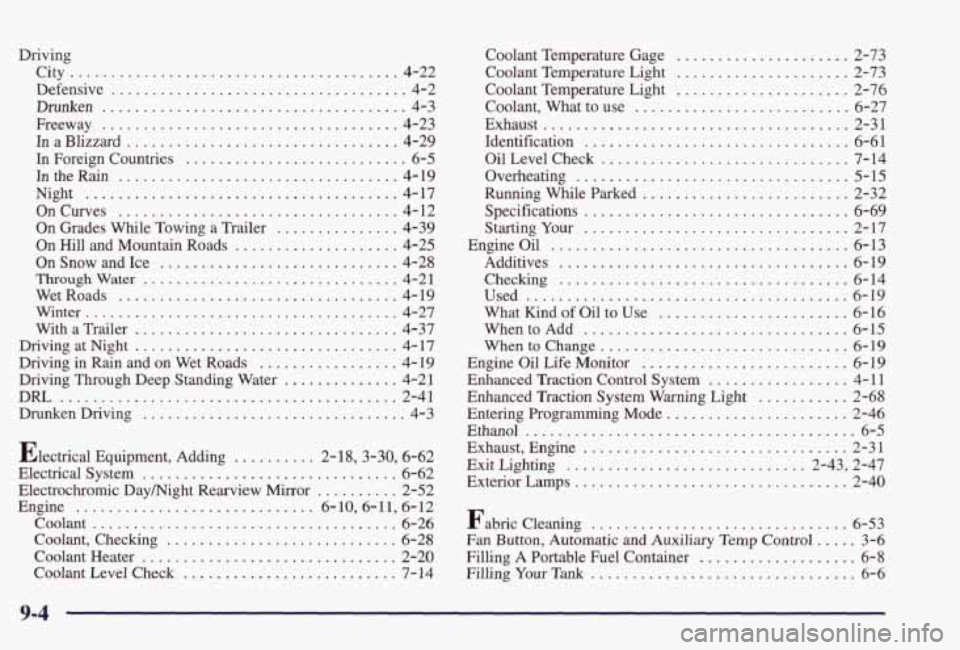
Driving City
................ ................... 4-22
Defensive
.................................. 4-2
Drunken
..................................... 4-3
Freeway
.................................... 4-23
In a Blizzard ................................. 4-29
In Foreign Countries ........................... 6-5
IntheRain
.................................. 4-19
Night
...................................... 4-17
On Curves .................................. 4-12
On Hill and Mountain Roads .................... 4-25
On Snow and Ice ............................. 4-28
Throughwater ............................... 4-21
WetRoads
.................................. 4-19
Winter
...................................... 4-27
WithaTrailer
................................ 4-37
Driving at Night
................................ 4-17
Driving in Rain and on Wet Roads
................. 4-19
Driving Through Deep Standing Water
.............. 4-21
DIU ......................................... 2-41
Drunken
Driving ................................ 4-3
On Grades While Towing a Trailer ............... 4-39
Electrical Equipment. Adding
.......... 2.18.3.30. 6.62
Electrical System
............................... 6-62
Electrochromic Daymight Rearview Mirror
.......... 2-52
Engine
............................. 6.10.6.11. 6.12
Coolant. Checking ............................ 6-28
Coolant Heater ............................... 2-20
Coolant Level Check
.......................... 7-14
Coolant ..................................... 6-26 Coolant Temperature Gage
.................... 2-73
Coolant Temperature Light
..................... 2-73
Coolant Temperature Light
..................... 2-76
Coolant. What to use
.......................... 6-27
Exhaust
.......... ...................... 2-31
Identification
................................ 6-61
OilLmelCheck
.............................. 7-14
Overheating
................................. 5-15
Running While Parked
......................... 2-32
Specifications
................................ 6-69
StartingYour ................................ 2-17
EngineOil
.................................... 6-13
Additives
................................... 6-19
Checking
................................... 6-14
Used ....................................... 6-19
What Kind of Oil to Use
....................... 6-16
When to Add
................................ 6-15
When to Change
.............................. 6-19
Engine Oil Life Monitor
......................... 6-19
Enhanced Traction Control System
................. 4-11
Enhanced Traction System Warning Light
........... 2-68
Entering Programming Mode
...................... 2-46
Ethanol ........................................ 6-5
Exhaust. Engine
................................ 2-31
Exit Lighting ............................. 2.43. 2.47
Exterior Lamps
................................. 2-40
Fabric Cleaning
............................... 6-53
Fan Button. Automatic and Auxiliary Temp Control ..... 3-6
Filling
A Portable Fuel Container ................... 6-8
Filling
Your Tank ................................ 6-6
9-4